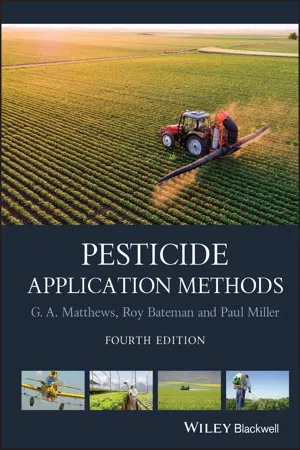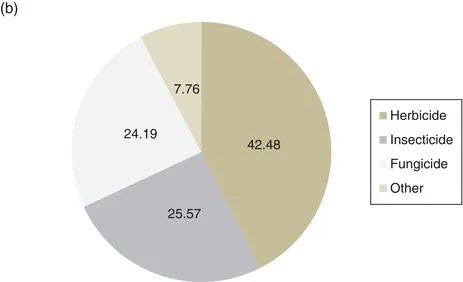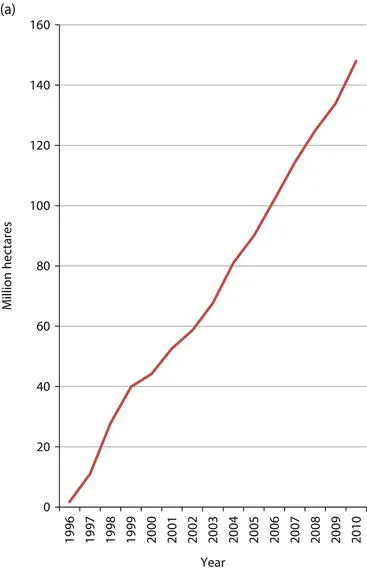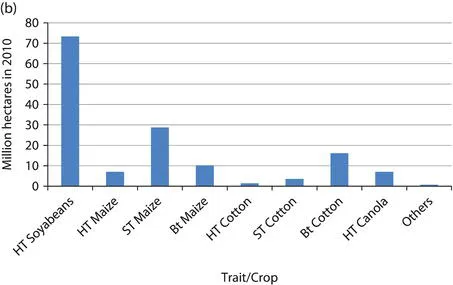![]()
Chapter 1
Chemical control in integrated pest management
Introduction
The human population continues to grow, especially in Asia and Africa, and the demand for food and other agricultural produce will continue to increase so it is not surprising that the market for pesticides continues to grow, despite innovative developments of genetically modified (GM) crops (Figure 1.1). In Europe, changes in legislation have significantly reduced the number of pesticides that can be marketed and their use must now form part of the EU Thematic Strategy on Pesticides (Stark, 2012). The restrictions have been in response to public perception of the risks associated with pesticide use in terms of residues in food and adverse effects on the environment. The perception is based erroneously on three false premises (van Emden and Peakall, 1996): that good crops were obtained in an ideal prepesticide era, that chemicals like pesticides never occur in nature, and that these unnatural pesticides are causing an increase in cancer. In practice, plants contain many chemicals which are highly toxic. For example, cyanide in cassava has to be removed by careful food preparation.
Without modern technology, including the use of pesticides, tripling world crop yields between 1960 and 1992, an additional 25–30 million square kilometres of additional land would have had to be cultivated with low-yield crops to feed the increased human population (Avery, 1997). Clearly, the use of pesticides plays an important role in optimising yields. Modern technology is changing and many pesticides, such as the persistent organochlorine insecticides, are no longer registered for use as newer, more active or selective chemicals take their place. Many chemicals are also being lost as companies are withdrawing support for them due to the cost of providing the additional data now required for registration, especially in Europe. At the same time, the agrochemical industry has invested in biotechnology and seed companies to exploit use of transgenic crops. The total area of transgenic crops has increased in 16 years to over 160 million hectares by 2011, involving over 16 million farmers in 29 countries (James, 2011) (Figure 1.2).
However, the growing of genetically modified crops has also aroused considerable public concern (Hill, 1998) and demands for legislation to control their use. While in many cases the transgenic crop is marketed on the basis that less pesticide will be used, other transgenic crops are associated with the application of particular herbicides, notably glyphosate used with ‘Roundup Ready’ crops. For insect control, insecticidal proteins from the soil bacterium Bacillus thuringiensis (Bt) are used. These toxins are proteins, called Crystal (Cry) and Cytolitic (Cyt), which have to be ingested by the insect pests as they kill by binding to specific target sites in the insect’s gut and disrupting the membrane. A single gene transfer expressing Cry 1 provides resistance to only one type of pest, and the gene has to express the toxin in the plant where the pest feeds and over the required period of crop growth when the pest causes economic damage. By stacking more than one Cry gene and combining with other insecticidal proteins, e.g.Vip toxins, insect control is improved and can extend the protection to a wider range of pests (Gatehouse, 2008), but other insect groups, especially sucking pests, may still have an adverse effect on a crop and require an insecticide treatment (Hilder and Boulter, 1999).
One new approach involves enhanced resistance to lepidopteran pests, by developing a transgenic cotton expressing an Australian funnel-web spider venom toxin omega-hexatoxin-Hv1a and this has been claimed to be as effective as pyramided Bollgard II® cotton for controlling major cotton pests (Omar and Ali Chatha, 2012). However, research on several new ideas, such as using genetic engineering to improve natural plant defences to repel aphids away from a crop (Beale et al., 2006) or expression of dsRNA (Huvenne and Smagghe, 2010; Price and Gatehouse, 2008), may provide a new generation of insect-resistant crops.
Furthermore, it has been quickly appreciated that pests resistant to the toxin in transgenic plants can be selected, as occurs with overuse of a chemical pesticide, so the new varieties have been introduced with insecticide resistance management strategies (Merritt, 1998). The planting of genetically modified plants is therefore similar to use of new varieties from traditional plant breeding, and in relation to pest management their availability provides another tool to be integrated in the cropping programme.
Despite the criticisms of pesticide use, farmers will continue to need to apply them as chemical control remains the most cost-effective and rapid way of combatting the effects of weed competition and crop loss due to pathogens and insect pests. Our knowledge of the chemistry and suitability of a increasingly wide range of pesticides can now provide a more rational approach to their use and avoid the adverse outcomes associated with extensive use of the persistent organochlorines and the highly toxic organophosphate insecticides. International efforts have improved registration and pesticides now commercially available have been rigorously evaluated with greater harmonisation of test procedures. Unfortunately, in many countries, especially in less developed areas, farmers have inadequate training and too often use the least expensive pesticide, irrespective of its suitability for the pest situation. It is also frequently highly toxic but the farmers do not have the appropriate protective clothing. In consequence, farmers in some areas have applied too many pesticide treatments and suffered economically and with poor health.
Modern farming practices have more intensive production of relatively few crops over large areas, while more traditional farming in tropical countries has a sequence of crops that provide a continual supply of food for polyphagous pests. Both these farming systems provide environments for pest populations to increase to such an extent that crop losses will occur unless control measures are implemented. Although these losses can be extremely serious and can result in total loss of a crop in some fields, for example the effect of an invasion of locusts or armyworms, the extent of damage is usually far less due to the intervention of natural enemies.
Considerable efforts have been put into training by means of farmer field schools, especially in relation to lowland irrigated rice production in South East Asia in an attempt to get farmers to recognise the importance of natural enemies. The difficulty for the farmer is knowing when a pest population has reached a level at which economic damage will occur so that preventive action can be taken. This decision should take into account the presence of natural enemies but sampling for these can be quite time consuming. Conservation of natural enemies is crucial in minimising the need for any chemical control, especially in the early vegetative stages of crop development. Areas with alfalfa or other fodder crops may provide a refuge for natural enemies; thus in Egypt, berseem clover assists the overwintering survival of lacewings which are important predators of cotton pests. However, the farmer will need a pesticide when quick action must be taken to avoid economic crop loss. Various methods of assessing pest populations are used to assist farmers determine when a pesticide may be applied as part of an integrated pest management programme.
Integrated pest management (IPM) utilises different control tactics (Figure 1.3) in a harmonious manner to avoid as far as possible undeirable side-effects on the environment. To many, this means avoiding the use of any chemical pesticide and growing crops organically but in many cases, such a system is not sustainable where high yields are required. In some situations, the public will pay a premium for organic produce but yields and quality can be lower in comparison with crops receiving minimal intervention with chemical control. In some cases, organic produce is said to taste better and this may be due to the choice of crop variety rather than not using any pesticide.
Weeds are frequently the most important factor during crop establishment at a time when demands for farm labour are high. Traditional hand weeding is very labour intensive and often not very effective, while general disturbance of soil by cultivation can increase erosion of some soils. Virtually weed-free conditions are possible with the range of herbicides now available and on some well-structured soils it is no longer necessary to plough every year as seed can be direct drilled after applying a broad-action herbicide, that is inactivated on contact with the soil. The area with a ‘no-till’ approach has increased as retaining crop residues conserves the soil and many of the beneficial organisms, such as earthworms, that are important in maintaining soil fertility. Their activity also has increased conservation of ground water so that crops suffer less during periods of drought. In Africa, no-till can be combined with growing strips of crops, interspersed with a line of Faidherbia albida trees, the ‘fertiliser tree’, as it sheds its nitrogen-rich leaves and contributes to improving the fertility of the soil (Barnes and Fagg, 2003).
Herbicide use has increased most where labour costs are high, there is a peak labour demand or where mechanical hoeing will cause damage to the young crop. In conjunction with other agronomic practices such as tie ridging and planting along contours, herbicide use can reduce soil erosion by minimising soil disturbance.
Improved row weeding either by hand hoeing or by application of a herbicide increased yields by up to 35% in West Africa (Carson, 1987). With changes to direct seeding of rice and other factors, herbicide usage has increased in many crops in the tropics where traditional labour is no longer readily available for hand weeding or hoeing. In order to minimise use of herbicides, methods of selective application have been developed and used in precision farming.
Wherever possible, farmers will select disease-resistant cultivars to reduce the need for fungicide treatments but in some situations, the farmer will continue to grow varieties which are susceptible to particular pathogens because of other qualities, such as taste and yield. The extensive damage to potato crops due to Phytophthora infestans that led to the Irish famine can be avoided by careful use of fungicides. Until a GM potato has been developed with resistance to Phytophthora, the risk of selecting strains resistant to the fungicide can be reduced if the number of applications is restricted by monitoring climatic conditions so that treatments can be timed to coincide with periods favourable to the pathogen. Field application of fungicide will often improve the quali...





